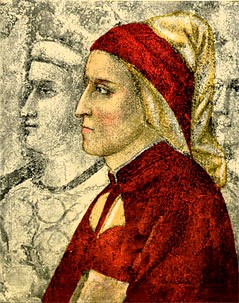..."For the comprehending, philosophy
 |
| Dante Alighieri |
Serves in more places than one to demonstrate
How Nature takes her own course from the design
Of the Divine Intelligence and Its art.
How Nature takes her own course from the design
Of the Divine Intelligence and Its art.
Study your Physics well, and you'll be shown
In not too many pages that your art's good
Is to follow Nature insofar as it can,
In not too many pages that your art's good
Is to follow Nature insofar as it can,
As a pupil emulates his master; God
Has as it were a grandchild in your art."
Has as it were a grandchild in your art."
- Inferno, XI, 93-101
When I first learned that one of Galileo Galilei's earliest professional achievements was delivering a lecture on the size and structure of Hell as described in Dante's Inferno, I was intrigued to say the least. I had always thought of the Commedia as a work of epic poetry and theological allegory, rich in poetry and symbolism, certainly, but I don't think I had ever considered that it might have been taken seriously in terms of natural philosophy - what we today would call Science. Apparently, however, it was taken rather seriously - seriously enough that a talk on the subject was integral to the early advancement of Galileo's career. I wanted to explore further this intriguing connection between the greatest of the medieval writers and one of the founders of modern science. What did Dante have to say that was of scientific interest and what influence had Dante had on the work and thought of Galileo?
Some time later, I came across this video on the topic, which emphasized Dante's impact on Galileo's thinking about scaling.
The idea is that the physical structure of an object, whether it is an animal or a bridge, has to depend on its size. As it says in the video, you can't just double the size of a horse to get an elephant. A double-sized horse wouldn't weigh twice as much, but eight (two cubed) times as much, so its legs would have to get thicker to support the additional weight. Changing the size of the structure also requires a change in its shape. So giant Lucifer chewing on Judas, Brutus and Cassius in his three mouths wouldn't be able to stand if he had the shape of a human being. His muscles would collapse and his bones break under his immense weight.
I am eager to read Mark Peterson's book Galileo's Muse, which is about the influence of arts and humanities on Galileo's thinking, but my local public library doesn't have it yet. Peterson, however, does have a paper about precisely this issue on arXiv, Galileo's Discovery of Scaling Laws. It was fascinating reading.
It turns out that although Galileo's lecture on the structure of Hell was a rhetorical and political success, he got the science exactly wrong. He defended the view of his fellow Florentine Antonio Manetti that Dante's Hell could be a cone roughly 3000 miles across at the top and extending to a point at the center of the Earth and that it could be covered by a ceiling of earth and rock 400 miles thick. The essence of Galileo's argument was that since these proportions were more than adequate to an architectural structure like Brunelleschi's Dome, they should work equally well if scaled up by a factor of 100,000.
The problem of course is that the weight of the roof won't increase linearly like its span and thickness. If you scale up its linear dimensions by 100,000, its volume (and therefore its weight) will increase by a factor of 100,000 x 100,000 x 100,000, one quadrillion times! There is no way a structure like that could support its own weight. Peterson suggests that Galileo realized his mistake soon after the talk, and subsequently developed a whole new theory of scaling which he was later to present in his Dialogues Concerning Two New Sciences.
The most fascinating thing to me is Peterson's argument that Galileo would develop this new theory and then sit on it for fifty years before publishing it. It highlights just how different the intellectual culture of Renaissance Italy was from the scientific culture of today. Galileo apparently developed the theory in order to defend himself in case anyone started poking holes in his original talk. Since he never needed it for that purpose, he didn't publish this revolutionary piece of science until nearly the end of his life.
The problem of course is that the weight of the roof won't increase linearly like its span and thickness. If you scale up its linear dimensions by 100,000, its volume (and therefore its weight) will increase by a factor of 100,000 x 100,000 x 100,000, one quadrillion times! There is no way a structure like that could support its own weight. Peterson suggests that Galileo realized his mistake soon after the talk, and subsequently developed a whole new theory of scaling which he was later to present in his Dialogues Concerning Two New Sciences.
The most fascinating thing to me is Peterson's argument that Galileo would develop this new theory and then sit on it for fifty years before publishing it. It highlights just how different the intellectual culture of Renaissance Italy was from the scientific culture of today. Galileo apparently developed the theory in order to defend himself in case anyone started poking holes in his original talk. Since he never needed it for that purpose, he didn't publish this revolutionary piece of science until nearly the end of his life.
No comments:
Post a Comment